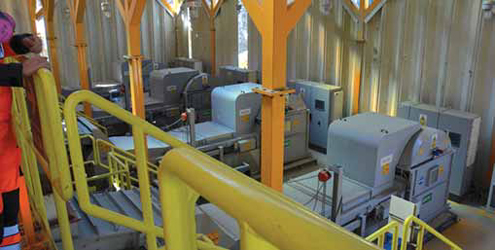2nd Hand Equipment - Coming soon!

We are now putting the final touches to the World Mining Equipment 2nd Hand market place. If you would like information on this service contact


Dalradian Resources, a Canadian junior exploration and development company, announced positive ore sorting test results based on a bulk sample of mineralized development material from several of the veins at its Curraghinalt gold project in Northern Ireland. Testing was carried out by Outotec at their TOMRA sorting test facility in Wedel, Germany, on approximately 5 metric tons (mt) of material grading 9.52 grams/mt of gold. Using X-ray and laser technology, plus additional screening prior to processing, the amount of non-mineralized material that would be sent to the mill in an operating mine was reduced by 35.8% and the grade increased by 54.6% to 14.72 g/mt of gold with a gold recovery of 99.3%.
Similar results would be expected if implemented into a mine-scale situation, according to the company, which noted that ore sorting technology has been used in diamond processing operations for many years and is now used with a variety of other commodities including tungsten and gold. The ore sorting process has become increasingly efficient with advancements in X-ray, laser and computer technology. It was anticipated that ore sorting would be a good fit at Curraghinalt because of the large contrast in density and color between the high-grade quartz-sulphide veins and the surrounding country rock.
Dalradian said throughout the testing, the ability to effectively sort the ore from Curraghinalt was clearly demonstrated. Using only X-ray technology with rougher stage material, waste removal of 50.5% with a gold recovery of 97.8% was achieved. When the laser scavenger step was added, which is used to recover additional mineralized material from the X-ray waste material, total gold recovery increased to 99.3% at the expense of a decrease in total waste removal to 35.8%. Optimization of the proposed process, including a cost benefit analysis of the secondary scavenger circuit, will be needed prior to implementation of the technology.
Eric Tremblay, Dalradian’s COO, said, “These are very good results. Independent testing proves our high-grade gold is easily sorted from waste. We plan to investigate it further by visiting operations using the technology prior to designing our own ore-sorting infrastructure for inclusion in an updated feasibility study.”
The company said ore sorting has the potential to considerably reduce costs at the mill by decreasing the amount of ore processed to produce the same number of ounces. Applying the results of the testing to the Curraghinalt deposit Mineral Reserve Estimate would potentially eliminate approximately 1.87 million mt of non-mineralized material prior to processing. Using the base case feasibility cost estimate of $27.8/mt for milling, this could result in savings of $52 million against a revenue loss of approximately $12.6 million (at $1,250/oz) due to recovery being reduced by 0.7%.
Application of ore sorting also has the potential to decrease the cut-off grade, which would result in more mineable ounces and increase the throughput of the mine.